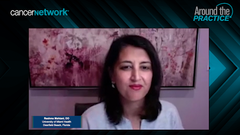
HER2+ Breast Cancer Findings Presented at ESMO 2021: Using T-DXd in Practice
Experts discuss the use of trastuzumab-deruxtecan (T-DXd) in clinical practice.
Episodes in this series

Sara Hurvitz, MD:Before we discuss how this data should be implemented in our clinical practice, I'd like to discuss another poster that was presented at ESMO [European Society for Medical Oncology], the updated overall survival results from DESTINY-Breast01 [NCT03248492]. Let’s talk about how you are using T-DXd in your practice based on these two posters. Dr Vijayakrishna, can you discuss the updated survival results?
Vijayakrishna Gadi, MD, PhD:This has already been published in the New England Journal of Medicine, which led to an FDA approval based on this early data. The trial was very complex, but ultimately we call it a phase 2 study. There was a PK [pharmacokinetics]stage, a dose-finding stage, and we found the selected dose of 5.4 mg per kg which became the dose for which over 180 patients were treated in a single arm. Some characteristics of those patients, the median age was 55 years, about 85% were high expressing for HER2 by immunohistochemistry—the remainder would've been FISH [fluorescence in situ hybridization] positive—patients with brain metastases were permitted if they were treated, and 92% had visceral disease. The characteristic that set this trial apart was the prior lines of therapy with a median of six prior lines, a heavily pretreated group. Regarding the overall survival, 52% of patients had experienced an OS [overall survival] event so the median OS was reportable at 29.1 months which is robust. After 6 lines of therapy to see patients live 2 -1/2 years longer with this therapy. The other data that was presented, that was also another secondary end point was the duration of response. The median duration of response was approximately 18 months. Patients could be on this drug durably, they we're able to benefit from it for a long time, even after seeing six lines of therapy. I call this an Nth line study because even in patients who'd seen a bunch of stuff before, this drug might have a real opportunity to help them. Now with the data that Dr Iyengar presented, this may shift to an earlier line, but for those patients that could benefit, it's still an option.
Sara Hurvitz, MD:That was a great review. Dr Mahtani please explain how you integrate this data into your own practice. What do you find compelling? Where are you positioning T-DXd [trastuzumab-deruxtecan] for metastatic disease?
Reshma Mahtani, DO:The promise of the waterfall plot with DESTINY-Breast01 was borne out when we saw this head-to-head randomized phase 3 data; prior to this, we had phase 2 data, it was a single-arm phase 2 study. We saw a head-to-head comparison with our current standard, which was trastuzumab emtansine. The other data point that stood out to me was the 16% CR [complete response] rate in patients on T-DXd. It is remarkable the progress that we've made in treating one of the most aggressive subtypes of breast cancer, we now have patients in a complete response. Many of the other responses were close to a CR. In my practice, this has become included as a second-line option. My challenge is not where to use it, but in what scenario where I wouldn't use it in the second-line.
Sara Hurvitz, MD:Dr Vijayakrishna, what do you think about the safety? From DESTINY-Breast01, we had a concern with deaths due to ILD [interstitial lung disease] with this agent, and now in the DESTINY-Breast03 [NCT03529110], there are no grade 4 or 5 events. The ILD overall rate dropped to about ten and a half percent. Why do you think this is and how has it changed your view of T-DXd and where you use it in practice?
Vijayakrishna Gadi, MD, PhD:When we get new drugs, we can be caught flatfooted and wondering how we can improve on this, but when we have the opportunity to understand what toxicity we observe in a phase 2 study we can adapt quickly. There may have been several things, and when the final publication is released we'll get a better sense of who got screened in and out. We've learned about patients who might be frail from a pulmonary standpoint, and are people we think twice about putting on this drug. Recognizing symptoms earlier might be consistent with ILD we might say we need to pause, take a break, let it resolve, start steroids, whatever management strategies we need to take part in, we can do. It's interesting that this trial is still ongoing in the sense that there are patients who are probably still on drugs and still being followed up in the context of the COVID-19 pandemic. I feel reassured that this is something we've learned as a community to be able to manage, for that toxicity. There are other toxicities, and some of them serious, but this one stands out, and to see no additional safety signals is reassuring both from DESTINY-Breast01 with longer follow up, but also from DESTINY-Breast03.
Sara Hurvitz, MD:I completely agree.
This transcript has been edited for clarity.
Newsletter
Stay up to date on recent advances in the multidisciplinary approach to cancer.





















































































